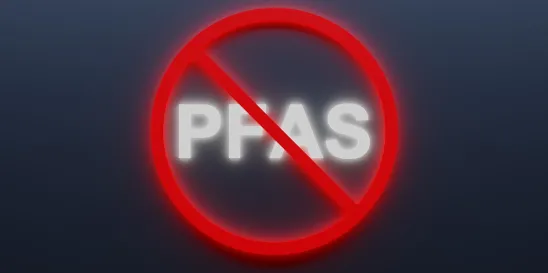As we have previously reported, PFAS (per- and polyfluoroalkyl substances) are a class of substances coming under increasing regulatory scrutiny. As manufacturers ring in the new year they should be aware of two new PFAS reporting requirements that could need careful attention in 2024.
De Minimis Exemption No Longer Available for PFAS Under EPCRA
Certain PFAS have been subject to Toxics Release Inventory (TRI) reporting under the Emergency Planning and Community Right to Know Act (EPCRA) since 2020. This reporting obligation began with an initial list of 172 PFAS, which has since expanded. That said, only a few dozen facilities submitted TRI reports for PFAS in each of the years since 2020. EPA followed up with facilities from which it had expected to receive filings, and reported that such facilities had concluded that TRI reporting was not necessary because of the de minimis exemption to TRI reporting. Under the de minimis exemption, substances present in mixtures in a concentration below 1 percent (or 0.1 percent for carcinogens) could be omitted from TRI reports. Since PFAS are often present in mixtures in very low concentrations the de minimis exemption essentially allowed almost all PFAS to remain unreported.
By a new rule published on October 31, 2023, EPA designated PFAS subject to TRI reporting as “chemicals of special concern” subject to enhanced reporting requirements. Because chemicals of special concern are not subject to the de minimis exemption to TRI reporting, and must be reported even in minute concentrations, this change will dramatically increase the amount of PFAS subject to reporting in the 2024 reporting year (2024 TRI filings are due July 1, 2025).
A second PFAS-related change to EPCRA reporting requirements has already gone into effect and might already be impacting your supply chain. EPCRA requires that certain suppliers of mixtures and/or trade name chemical products must disclose to their customers the presence of any TRI-reportable substance in their products unless such substance is present below the de minimis concentration of 1 percent (0.1 percent for carcinogens). In the same October 31 final rule, EPA also eliminated the use of the de minimis exemption to supplier notification requirements for any chemicals of special concern (including TRI-reportable PFAS, and also lead, mercury, and other chemicals of special concern). As a result, manufacturers may soon learn that products in their supply chain contain small concentrations of PFAS that would not have been previously reported or disclosed because they would have been below the de minimis threshold. This enhanced knowledge would in turn also inform TRI reports for the chemicals of special concern.
TSCA Reporting Rule for Manufacturers and Importers
Under a new PFAS reporting rule promulgated under the Toxic Substances Control Act on October 11, 2023, any entity that manufactured (including imported) PFAS or PFAS-containing articles in any year since 2011 must provide EPA information on PFAS identity, concentration, uses, production volumes, disposal, exposures, and hazards. The definition of PFAS under TSCA is much broader than under EPCRA (defined by chemical properties rather than a list of substances) and could apply to thousands of different compounds.
It is important to note that TSCA defines manufacturing to include importing. Furthermore, unlike some other TSCA reporting requirements, the new PFAS reporting rules will apply to finished product “articles” in addition to bulk chemicals, so importers of finished articles are subject to reporting rules for products that might have had PFAS added several steps earlier in the supply chain. For example, a jacket made from fabric that has been treated with a PFAS-containing water-repellent coating would be considered a PFAS-containing article subject to the reporting rule if imported since January 1, 2011.
The more complex the item, and the more different components are included, the more opportunities for PFAS-containing components to be present. Even something simple like a desktop speaker could include wires (potentially sheathed with PTFE), plastic casing (which may have been strengthened with PFAS-imparting processes), and fabric (treated with a PFAS-containing water and stain-repellent coating). Fortunately, manufacturers and importers are only required to provide the information “known to or reasonably ascertainable” by the filer, and for earlier years in the reporting period, there might be little, if any, information available. Even so, a careful examination of the supply chain and related records may be required in order to understand your reporting obligations and/or document what information (if any) is known or reasonably ascertainable.
Reporting forms are due within 18 months after the effective date of the rule (i.e., by May 13, 2025) except for small article importers, who must report within 24 months after the effective date (i.e., by November 13, 2025).



 />i
/>i
